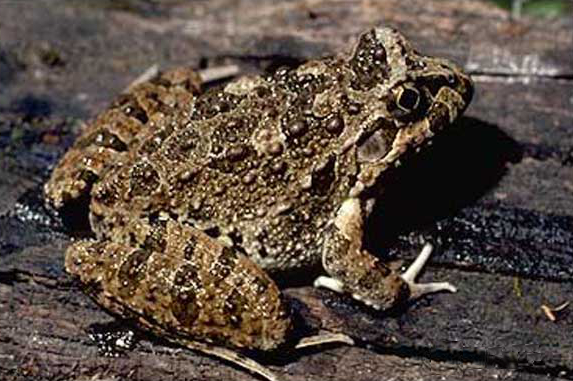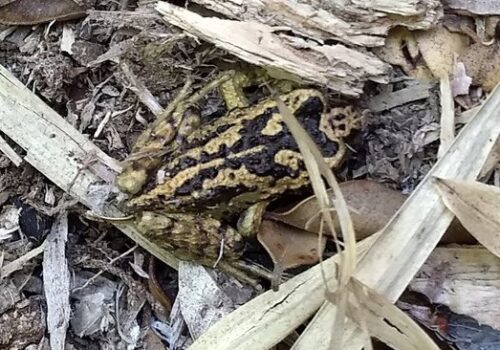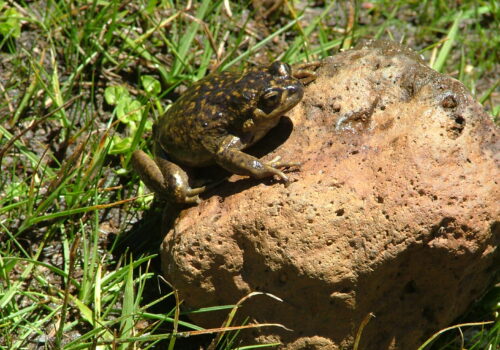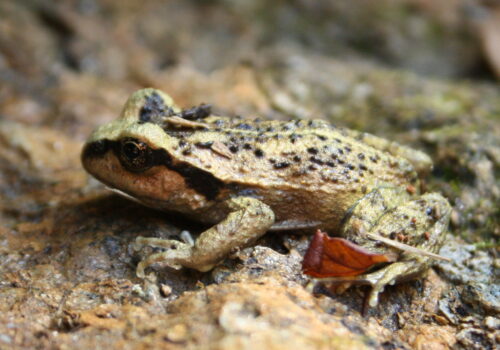- Exploring the Enigmatic World of Limnomedusa macroglossa: The Long-Tongued Swamp Frog
- Taxonomy and Classification of Limnomedusa macroglossa
- The Natural Habitat: Forest Streams and Subtropical Marshes
- Physical Characteristics: Master of Camouflage and Adaptation
- Behavior and Life Cycle: Elegantly Coordinated Survival
- The Ecological Role of Limnomedusa macroglossa
- Conservation Status and Threats
- Cultural and Scientific Significance
- Conclusion: Honoring the Hidden Jewel of Our Wetlands
Exploring the Enigmatic World of Limnomedusa macroglossa: The Long-Tongued Swamp Frog#
In the humid shadows of gently flowing streams and swampy marshes tucked away in subtropical South America’s lush forests, a rather peculiar frog emerges as twilight paints the sky. This elusive amphibian, known scientifically as Limnomedusa macroglossa, or commonly as the Long-Tongued Swamp Frog, strikes a chord of fascination among ecologists and nature enthusiasts alike. Distinguished primarily by a remarkably elongated tongue—one so notable that it has earned a place within its very species name—L. macroglossa remains a charmingly mysterious resident of its habitats, inspiring scientists and igniting curiosity among those fortunate enough to encounter it.
Though frogs generally conjure images of common pond-dwelling creatures or vibrant tropical tree frogs, Limnomedusa macroglossa offers something subtler, deeper, woven into the ecological fabric of its unique habitat. Its natural history and ecological importance reveal a nuanced story of adaptation and survival, a delicate yet profoundly interconnected existence within a meticulously balanced ecosystem. Moreover, this intriguing frog harbors secrets that may illuminate broader conservation questions and help biologists better understand amphibian health in rapidly changing environments.
Taxonomy and Classification of Limnomedusa macroglossa#
To fully appreciate the Long-Tongued Swamp Frog’s singular place in nature, we must begin with its taxonomic identity. Classified within the family Alsodidae—a group of neotropical frogs found primarily in South America—Limnomedusa macroglossa occupies its own distinct genus, Limnomedusa, highlighting its specialized evolutionary history. The genus Limnomedusa currently comprises a single recognized species, emphasizing its unique evolutionary lineage among amphibians.
First described scientifically in detail by Duméril & Bibron in 1841, the long-tongued swamp frog is closely related to other South American species within the Alsodidae family. Yet, its distinctive morphological and ecological traits firmly set it apart, making it uniquely valuable to scientists searching for insights into amphibian evolution, biology, and conservation.
The Natural Habitat: Forest Streams and Subtropical Marshes#
Geographical Range and Distribution#
Limnomedusa macroglossa dwells primarily within subtropical forested regions of southeastern Brazil, Uruguay, northeastern Argentina, and Paraguay. In these areas, this frog remains somewhat elusive, favoring secluded freshwater habitats where slow-moving streams meander among lush greenery and shady forest canopies form living umbrellas overhead.
Within these regions, pockets of stable populations flourish, drawing their existence from the ecological bounty provided by these richly biodiverse areas. The interconnectivity of forest streams, marshes, and wetlands provides critical corridors facilitating movement, essential for breeding and genetic exchange, ensuring the long-term survival and resilience of the species.
Habitat Preferences: Life Among Leaf Litter and Shallow Freshwater#
Observing a habitat preferred by a Long-Tongued Swamp Frog offers soothing visuals of gently flowing freshwater surrounded by dense understories and moss-covered logs. Their habitats are characterized by abundant leaf litter, fallen branches, and moist soil layers enriched by consistent rainfall. This complexity supports diverse invertebrate populations, upon which the swamp frog feeds enthusiastically.
These amphibians seldom stray far from water, preferring submerged tree roots, muddy banks, or marshy vegetation where they have quick refuge from predators. The intricate architecture of such habitats grants this secretive animal ideal conditions—abundant prey, suitable sites for breeding, and excellent protective cover from terrestrial and aerial predators.
Physical Characteristics: Master of Camouflage and Adaptation#
The appearance of Limnomedusa macroglossa represents a remarkable example of evolutionary adaptation and camouflage. Adults typically measure between 4–6 centimeters—fit neatly within a human palm—with stocky bodies perfectly adapted to life concealed beneath vegetation or within muddy burrows. Their smooth yet slightly granular skin, dappled shades of brown, olive, or muted green, blends impeccably with the mud and leaf litter of their surroundings, providing exceptional camouflage from predators.
The defining characteristic from which this species earns its scientific name is indeed its impressively elongated tongue. Compared with other frogs of similar size, the long-tongued swamp frog possesses a tongue noticeably more extensible and accurate, enabling them to expertly capture fast-moving prey such as insects and small invertebrates. Such precision and efficiency provide critical dietary advantages, further facilitating their survival within competitive ecosystems.
Their powerful hind limbs, endowed with webbing adapted to semi-aquatic locomotion, afford them exceptional mobility and agility in both terrestrial and aquatic environments. On land, they effortlessly navigate moist forest floors littered with obstacles, whereas in water, they glide and leap confidently, swiftly maneuvering between hiding spots or ambushing prey.
Behavior and Life Cycle: Elegantly Coordinated Survival#
A Specialized Diet and Hunting Prowess#
At twilight, the quiet hum of insects fills the air, inspiring an orchestral night chorus performed by countless swamp inhabitants. Amidst this sonic tapestry, Limnomedusa macroglossa emerges from concealed resting spots, primed for the night’s hunt. Patient and stealthy predators, these frogs rely on keen eyesight and remarkable reflexes to detect insect prey. The extended tongue flashes unseen, piercing through the evening shadow, and drawing small preys swiftly into waiting mouths.
Their diet predominantly consists of insects and small invertebrates, such as beetles, moth larvae, crickets, and spiders, underscoring their critical ecological role as regulators of insect populations in their habitats. The nocturnal hunting patterns further shield the frogs from potential predators, balancing risk and reward within their environmental niche.
Mating Rituals and Parental Care#
Primarily active during warmer, wetter seasons, the breeding rituals of this cryptic amphibian represent elegant adaptations to seasonal cycles. Male swamp frogs establish small territories near sheltered water bodies, emitting subtle but distinctive mating calls resonating gently amid the stillness. Females, guided by these calls, arrive to deposit gelatinous clutches of eggs among submerged vegetation, ensuring effective concealment and protection from predators.
The development cycle from egg to fully metamorphosed frog parallels a delicately choreographed ballet. Newly hatched tadpoles swiftly scatter and find refuge within aquatic vegetation, algae mats, or submerged litter, feeding voraciously on microscopic aquatic organisms until metamorphosis allows them to breathe air and venture into terrestrial life, thus perpetuating a magnificent cycle critical to ecosystem health.
The Ecological Role of Limnomedusa macroglossa#
Within their ecosystem, the long-tongued swamp frogs fulfill essential roles at multiple trophic levels. They diligently control insect populations, thus indirectly influencing vegetation health and preventing outbreaks of pests that might otherwise damage plant communities or agricultural crops. In turn, their presence provides a vital food source for diverse bird populations, snakes, mammals, and larger predatory amphibians, energetically connecting food webs within subtropical ecosystems.
The health and stability of swamp frog populations serve as sensitive biological indicators. Fluctuations in their population numbers may hint at broader ecosystem disturbances, such as water contamination, accelerating habitat fragmentation, or climate-related shifts, thus alerting conservationists to potential environmental risks requiring attention.
Conservation Status and Threats#
Although currently classified by the International Union for Conservation of Nature (IUCN) as “Least Concern,” existing healthy populations might conceal future vulnerabilities. Habitat destruction due to rapid urbanization, agriculture, logging, and industrial activity in its range countries poses potential threats. Pollution from pesticides and industrial discharge further complicates habitat health, potentially impairing frog reproduction and overall amphibian well-being.
Climate change scenarios predict altered rainfall patterns, warmer temperatures, and increasingly erratic seasonal shifts—all threatening subtropical wetlands that support these frogs. Monitoring populations remains vital for early detection of threats, guiding preventive conservation measures that maintain healthy wetland habitats, promoting connected wildlife corridors, and ensuring clean water and abundant vegetation.
Cultural and Scientific Significance#
Beyond ecological importance, Limnomedusa macroglossa encourages deeper conservation conversations, illuminating broader issues faced by amphibians globally. Each unique adaptation, every behavioral habit elucidated through ongoing scientific study, offers pivotal insights into frogs’ resilience and vulnerability alike, enhancing conservation education and awareness. Local communities view this unobtrusive, secretive frog as an integral symbol of healthy, flourishing wetlands and ecosystems, signifying undiminished natural wealth.
Conclusion: Honoring the Hidden Jewel of Our Wetlands#
Ultimately, the preservation of Limnomedusa macroglossa and its enchanting subtropical swamp habitats encapsulates our shared responsibility toward Earth’s remarkable biodiversity. By understanding, protecting, and celebrating this discreet yet invaluable resident of our natural world, we honor nature’s genius and reaffirm our conservation commitment, ensuring these charming creatures serenade the night skies for generations yet unborn.


















